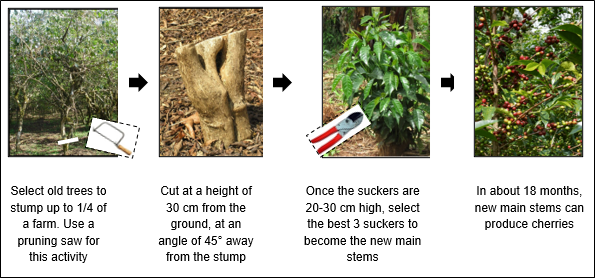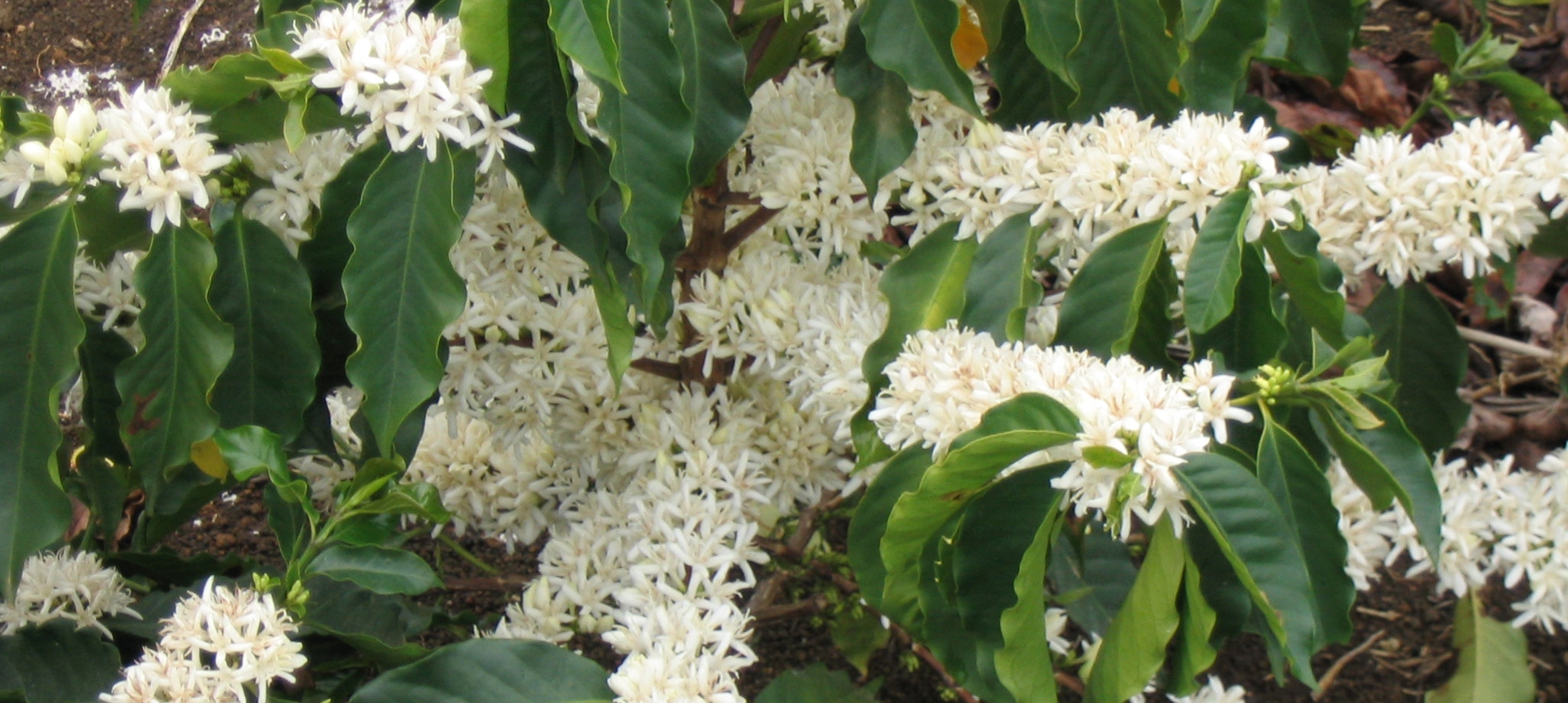What is stumping and why is it important?
Stumping is the practice of rejuvenating older coffee trees by cutting all their main stems, to encourage vigorous new growth. In Ethiopia, farmers stump trees after harvesting, one to two months before flowering. Stumping is known to increase coffee tree yields substantially, when practiced along with other best agronomic practices. (Scroll to the end to find out how to stump a coffee tree.)
The catch is that after stumping, coffee tree production is zero for one year and quite low in the following season. This loss of revenue from the first two years of adoption makes farmers reluctant to stump despite the long-term yield benefits.
So the question is: how can farmers be encouraged to adopt stumping as a best practice?
A possible solution?
Laterite launched the Tools for Stumping (TFS) pilot program in 2020 in partnership with HereWeGrow and international development nonprofit TechnoServe. The pilot targeted 1,500 smallholder coffee farmers in two kebeles (kebele is the lowest administrative unit of Ethiopia) of the Sidama region registered in the TechnoServe Farm College group training program. We also selected two additional control kebeles with about 1,500 coffee farmers.
The pilot was designed as a one-time intervention to nudge farmers to stump their older coffee trees and learn more about the feasibility and scalability of this approach. As an incentive, farmers who stumped more than 50 coffee trees between January and March 2020 were eligible to receive a package of farming tools, and these packages increased in value with number of trees stumped.
The stumping adoption rates at the end of the pilot program were higher than in the comparison group, suggesting that it was worth testing this approach at a larger scale in an experimental setting.
The pilot also taught us important lessons on what works and what doesn’t. Learning from our mistakes at the pilot stage will help us with the scale-up.
What works?
Early buy-in is key
Smallholder coffee farmers are at the heart of this pilot program and tailoring the incentives package to their needs was a critical component to success. To determine the right incentives mix, we followed a two-step process. First, we consulted closely with our partners and local government officials, weighing cash versus alternative incentives to support farmers. Although cash is easier to deliver, local officials were worried that cash would create dependency and, instead, encouraged the use of assets as incentives. Next, together with TechnoServe’s field team, we decided to explore the root of farming tools as an incentive and reached out to farmers to compile a list of the farming tools they found to be the most useful.
Early buy-in from government officials and TechnoServe staff contributed to creating the right conditions, enthusiasm and local support for this pilot. We are confident that the tools-based incentives were in line with the farmers’ needs, but for the scale-up would recommend a more consultative process involving farming households from the get-go. Timelines for the pilot were tight, and while we were able to involve coffee-farmers, decisions had to be made quickly.
Think about how you can use existing resources
The largest logistical hurdles for this pilot were spreading the word about the program, and procuring and distributing the tools. At scale, these challenges can prove to be even more problematic if not ironed out at the pilot stage.
Farmers involved in the TechnoServe training program interact with a trainer at least once per month in a group setting and through individual farm visits. This interaction created an opportunity for disseminating information about the pilot program to about 1,500 coffee farmers without having to search for participants, which would have been a more costly and time-consuming exercise. All the farmers that attended the TechnoServe training session received the details about the program, the incentives, and the eligibility criteria.
In Sidama, farming tools are not readily available in large quantities and the distance from Addis Ababa doesn’t make distribution easy either. We solved this problem by mobilizing TechnoServe’s contacts in the coffee farming industry to procure tools from Addis Ababa and transport them to Sidama. And as for distribution of tools to individual farmers, Laterite relied on the TechnoServe field team to meet with a group of farmers in each kebele to distribute the tools. During distribution, the team filled out a form on SurveyCTO with the signature and picture of the farmers with their tools.
All in all, for such a pilot design with many logistical hurdles, it is important to make the best use of the resources already established on the ground.
Test the data collection protocols
Verifying and counting stumped coffee trees is not an easy feat if you have to visit 1,500 farms. This was for the pilot. At scale it would take many data collection days just to identify farmers with stumped coffee trees. Once again, we relied on the existing TechnoServe structures to design a protocol for verification of farmers with stumped coffee trees.
The first part of the task was checking the stumping status of each farmer. To do this, we reached out to the trainer and the focal farmer in each training group. They provided an initial list of all the farmers that had stumped their coffee and the ones that had not. We only visited and verified the coffee fields of farmers that had been identified as adopters. This on the one had made the verification exercise significantly cheaper, albeit with a small risk of missing out on certain farmers that had stumped but had not been flagged by the focal-farmers and farmer-trainers.
The second task involved counting the stumped coffee trees in each farm, using a reliable and accurate process. We worked with our data team to establish a systematic way of counting trees per row to make sure that enumerators did not miss any. We decided to test this protocol before finalizing it to establish greater confidence in the procedure. This was when we realized that farmers did not always stump or plant trees in clear rows so we had to adjust the protocol before sending out a larger enumerator team to the field. Testing and re-designing a protocol are key steps towards accurate data collection, which is even more important when the outcome determines the incentives package.
Learn before scaling
Early buy-in from stakeholders, taking advantage of existing structures and testing field protocols were fundamental to the success of this pilot program. The operational feasibility of a pilot program is just as important if not more than the results before scaling-up.
Despite all the mistakes and lessons learned from this pilot program, a few things remain to be figured out before scaling. Are tools the best and sustainable incentive to encourage farmers? Are there better and more automated ways to count stumped coffee trees? How can we get first-hand information from farmers about the stumping status without having to visit their farm?
—
Ravina Pattni is a Research Associate at Laterite Ethiopia.
Cover photo: Marcelo Correa, via WikimediaCommons
How to stump a coffee tree, according to the TechnoServe training manual

